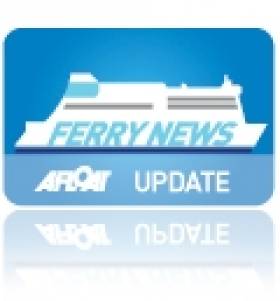Displaying items by tag: Aviva Stadium
US Navy Amphibious Vessel Visits Dublin Port in Advance of American College Football Match
A naval visitor arrived to Dublin Port this afternoon as the USS Mesa Verde is on a courtesy call to the capital to coincide with an American football match classic which is to be held tomorrow, Saturday.
The United States Navy USS Mesa Verde is a San Antonio-class amphibious transport dock vessel which had departed Narvik, Norway following what is understood to be training exercises held with their NATO Nordic ally.
Upon arrival to Dublin port’s fairway, tugs approached the naval vessel to the Deepwater Berth on the south quays.
Attending the USS Mesa Verde, Afloat noted the tugs Beaufort at the bow whereas Shackleton and Giano were on duty off the stern of the large naval vessel which docked at Berth 46. This part of the port is a restricted operational area and where such larger naval visitors berth.
USS Mesa Verde is visiting Dublin Port ahead of the 2023 Aer Lingus College Football Classic between Navy Midshipmen and the Notre Dame Fighting Irish. Up to 40,000 spectators are expected at the Aviva Stadium on Lansdowne Road including crew and marines of the 699 personnel of the foreign naval vessel.
In addition to tomorrow evening's sporting event in Ballsbridge, US military aircraft will be making a flyover above the capital.
Prior to the vessel’s arrival, the Naval Service OPV90 /P60 series leadship, L.E. Samuel Beckett had this morning berthed upriver at Sir John Rogerson's Quay.
The L.E. Samuel Beckett is one of just two operational patrol vessels of the Naval Service will be making a shorter call in the capital whereas the USS Mesa Verde is to remain until Tuesday morning.
Stena Line's HSS Service Sounds Good for Lady Gaga
#LADY GAGA– Stena Line's HSS Stena Explorer is set to return to Dun Laoghaire Harbour this Sunday, despite last Tuesday's end of season sailings to Holyhead, as previously reported on Afloat.ie. The HSS has been specially chartered in to transport stage trucks following the Lady Gaga concert to be held this weekend in Dublin, writes Jehan Ashmore.
The US pop-star is to play her only Irish tour date on Saturday night in the Aviva Stadium. Following the New York musician's 'The Born This Way Ball' performance, the stage equipment is to be transported from the Ballsbridge venue by a convoy of 25 freight trucks to the ferryport in Dun Laoghaire for the sailing to Holyhead.
On arrival of the HSS into Dun Laoghaire, the fast-ferry will be in a 'light' mode, i.e. no passengers or vehicles on board. However on the return leg to Anglesey, the craft will be loaded with the stage trucks on the vehicle decks that are capable of loading in total 50 lorries (each of 15m in length).
Upon arrival in Holyhead, the truck convoy will travel 'landbridge' across the UK as they proceed onward to The Netherlands, where the tour continues in Amsterdam, at the cities Ziggo Dome.
However normal HSS sailings are to resume for 12 days over the Christmas /New Year period, for further information visit: www.stenaline.ie/ferry/book-now/hss-christmas-sailings-2012/






























































